Pedestrian Counting Based on Piezoelectric Vibration Sensor
Abstract
:1. Introduction
- We propose a novel approach that can count the number of people with vibration signals from the piezoelectric sensors while protecting privacy.
- Our approach supports the situations where multiple people walk together with the signals mixed.
- Our approach does not require that only one group of people should be in the detection area.
- Different from the room-level approach [14], our approach is a step-level pedestrian counting approach, making it more appropriate for many real-world applications.
- Our approach uses piezoelectric sensors, which are much cheaper than geophone sensors, making our solution economically viable.
- Experimental evaluation shows that our approach outperforms the vibration signal based state-of-the-art methods in accuracy for similar pedestrian counting task.
2. Related Work
2.1. Sensor Selection
2.2. Vibration Signal-Based Approaches
2.3. Overview of Our Approach
- Our approach can detect the number of pedestrians in an area while making no strict requirement about the number of groups of walking people in the detected area.
- Our approach supports the use cases where multiple people walk together with their signals mixed.
- Our approach uses the piezoelectric sensor, which is much cheaper than the geophone sensor used in previous approaches, making our approach economically viable.
3. Problem Formulation
3.1. Problem Definition
- Footsteps from different pedestrians are fully synchronized in terms of striking timing.
- Footsteps from different pedestrians are off-sync, but induced vibration signals presents temporal overlapping.
- Footsteps are temporally staggered.
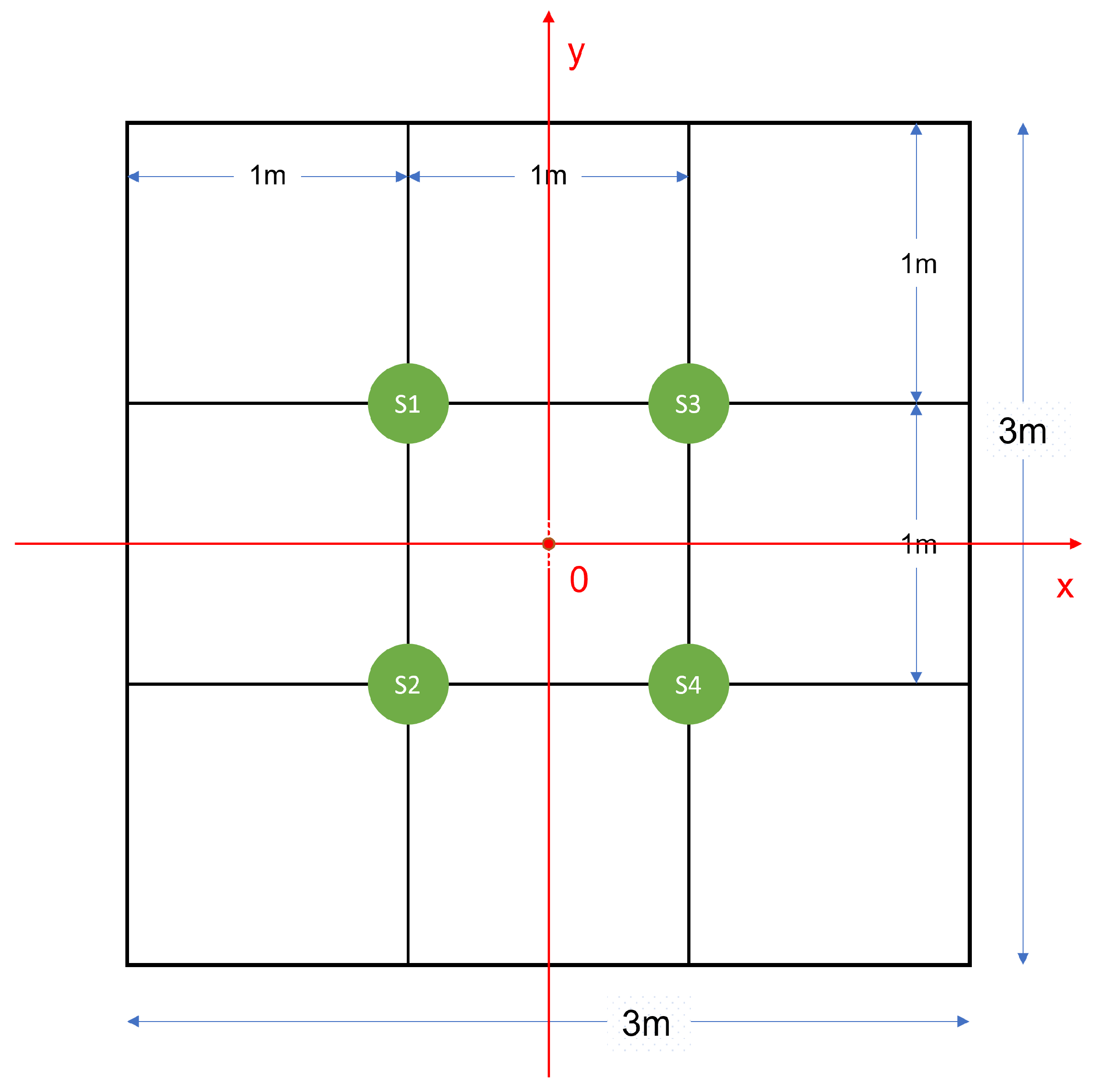
3.2. Problem Analysis
4. System Design
4.1. Data Acquisition
4.2. Preprocessing
4.2.1. Normalization and Downsampling
4.2.2. Signal Selection and Event Detection
4.3. Data Set Collection and Deep Learning Model
4.3.1. Data Collection
4.3.2. Deep Learning Model
4.4. Prediction Output Judgment Logic
5. Evaluation
5.1. Data Preparation for K-Fold Cross-Validation
5.2. Performance
6. Conclusions and Future Work
Author Contributions
Funding
Acknowledgments
Conflicts of Interest
References
- Hussain, S.; Yu, Y.; Ayoub, M.; Khan, A.; Rehman, R.; Wahid, J.A.; Hou, W. IoT and Deep Learning Based Approach for Rapid Screening and Face Mask Detection for Infection Spread Control of COVID-19. Appl. Sci. 2021, 11, 3495. [Google Scholar] [CrossRef]
- Fierro, G.; Rehmane, O.; Krioukov, A.; Culler, D. Zone-Level Occupancy Counting with Existing Infrastructure. In BuildSys ’12: Proceedings of the Fourth ACM Workshop on Embedded Sensing Systems for Energy-Efficiency in Buildings, Toronto, ON, Canada, 6 November 2012; Association for Computing Machinery: New York, NY, USA, 2012; pp. 205–206. [Google Scholar] [CrossRef]
- Corna, A.; Fontana, L.; Nacci, A.A.; Sciuto, D. Occupancy Detection via iBeacon on Android Devices for Smart Building Management. In Proceedings of the 2015 Design, Automation Test in Europe Conference Exhibition (DATE), Grenoble, France, 9–13 March 2015; pp. 629–632. [Google Scholar] [CrossRef] [Green Version]
- Conte, G.; De Marchi, M.; Nacci, A.A.; Rana, V.; Sciuto, D. BlueSentinel: A First Approach Using iBeacon for an Energy Efficient Occupancy Detection System. In Proceedings of the BuildSys @ SenSys, Memphis, TN, USA, 3–6 November 2014; pp. 11–19. [Google Scholar]
- Krumm, J.; Harris, S.; Meyers, B.; Brumitt, B.; Hale, M.; Shafer, S. Multi-Camera Multi-Person Tracking for EasyLiving. In Proceedings of the Third IEEE International Workshop on Visual Surveillance, Dublin, Ireland, 1 July 2000; pp. 3–10. [Google Scholar] [CrossRef]
- Hnat, T.W.; Griffiths, E.; Dawson, R.; Whitehouse, K. Doorjamb: Unobtrusive Room-Level Tracking of People in Homes Using Doorway Sensors. In SenSys ’12: Proceedings of the 10th ACM Conference on Embedded Network Sensor Systems, Toronto, ON, Canada, 6–9 November 2012; ACM Press: Toronto, ON, Canada, 2012; p. 309. [Google Scholar] [CrossRef]
- Narayana, S.; Prasad, R.V.; Rao, V.S.; Prabhakar, T.V.; Kowshik, S.S.; Iyer, M.S. PIR Sensors: Characterization and Novel Localization Technique. In IPSN ’15: Proceedings of the 14th International Conference on Information Processing in Sensor Networks, Seattle, WA, USA, 13–16 April 2015; ACM: Seattle, DC, USA, 2015; pp. 142–153. [Google Scholar] [CrossRef]
- Song, J.; Dong, Y.F.; Yang, X.W.; Gu, J.H.; Fan, P.P. Infrared Passenger Flow Collection System Based on RBF Neural Net. In Proceedings of the 2008 International Conference on Machine Learning and Cybernetics, Kunming, China, 12–15 July 2008; Volume 3, pp. 1277–1281. [Google Scholar] [CrossRef]
- Xia, L.; Chen, C.C.; Aggarwal, J.K. Human Detection Using Depth Information by Kinect. In Proceedings of the CVPR 2011 WORKSHOPS, Colorado Springs, USA, 21–23 June 2011; pp. 15–22. [Google Scholar] [CrossRef] [Green Version]
- Xu, C.; Firner, B.; Moore, R.S.; Zhang, Y.; Trappe, W.; Howard, R.; Zhang, F.; An, N. SCPL: Indoor Device-Free Multi-Subject Counting and Localization Using Radio Signal Strength. In IPSN ’13: Proceedings of the 12th International Conference on Information Processing in Sensor Networks, Philadelphia, PA, USA, 8–11 April 2013; Association for Computing Machinery: New York, NY, USA, 2013; pp. 79–90. [Google Scholar] [CrossRef]
- Xu, C.; Firner, B.; Zhang, Y.; Howard, R.; Li, J.; Lin, X. Improving RF-Based Device-Free Passive Localization in Cluttered Indoor Environments through Probabilistic Classification Methods. In Proceedings of the 2012 ACM/IEEE 11th International Conference on Information Processing in Sensor Networks (IPSN), Beijing, China, 16–19 April 2012; pp. 209–220. [Google Scholar] [CrossRef]
- Zhang, D.; Liu, Y.; Guo, X.; Ni, L.M. RASS: A Real-Time, Accurate, and Scalable System for Tracking Transceiver-Free Objects. IEEE Trans. Parallel Distrib. Syst. 2013, 24, 996–1008. [Google Scholar] [CrossRef]
- Zhang, P.; Martonosi, M. LOCALE: Collaborative Localization Estimation for Sparse Mobile Sensor Networks. In Proceedings of the 2008 International Conference on Information Processing in Sensor Networks (Ipsn 2008), St. Louis, MI, USA, 22–24 April 2008; pp. 195–206. [Google Scholar] [CrossRef]
- Pan, S.; Bonde, A.; Jing, J.; Zhang, L.; Zhang, P.; Noh, H.Y. BOES: Building Occupancy Estimation System Using Sparse Ambient Vibration Monitoring. In Proceedings of the SPIE Smart Structures and Materials + Nondestructive Evaluation and Health Monitoring, San Diego, California, USA, 9–13 March 2014; Lynch, J.P., Wang, K.W., Sohn, H., Eds.; p. 90611O. [Google Scholar] [CrossRef]
- Pan, S.; Mirshekari, M.; Zhang, P.; Noh, H.Y. Occupant Traffic Estimation through Structural Vibration Sensing. In SPIE Smart Structures and Materials + Nondestructive Evaluation and Health Monitoring; Lynch, J.P., Ed.; 2016; p. 980306. [Google Scholar] [CrossRef]
- Pan, S.; Mirshekari, M.; Fagert, J.; Ruiz, C.; Noh, H.Y.; Zhang, P. Area Occupancy Counting Through Sparse Structural Vibration Sensing. IEEE Pervasive Comput. 2019, 18, 28–37. [Google Scholar] [CrossRef]
- Hafeezallah, A.; Al-Dhamari, A.; Abu-Bakar, S.A.R. U-ASD Net: Supervised Crowd Counting Based on Semantic Segmentation and Adaptive Scenario Discovery. IEEE Access 2021, 9, 127444–127459. [Google Scholar] [CrossRef]
- Liu, L.; Jiang, J.; Jia, W.; Amirgholipour, S.; Wang, Y.; Zeibots, M.; He, X. DENet: A Universal Network for Counting Crowd With Varying Densities and Scales. IEEE Trans. Multimed. 2021, 23, 1060–1068. [Google Scholar] [CrossRef]
- Hafeezallah, A.; Abu-Bakar, S. Crowd Counting Using Statistical Features Based on Curvelet Frame Change Detection. Multimed. Tools Appl. 2017, 76, 15777–15799. [Google Scholar] [CrossRef]
- Wang, Z.; Li, W.; Shen, Y.; Cai, B. 4-D SLAM: An Efficient Dynamic Bayes Network-Based Approach for Dynamic Scene Understanding. IEEE Access 2020, 8, 219996–220014. [Google Scholar] [CrossRef]
- Zhang, C.; Li, H.; Wang, X.; Yang, X. Cross-Scene Crowd Counting via Deep Convolutional Neural Networks. In Proceedings of the IEEE Conference on Computer Vision and Pattern Recognition, Boston, MA, USA, 7–12 June 2015; pp. 833–841. [Google Scholar]
- Geophone—SM-24—SEN-11744—SparkFun Electronics. Available online: https://www.sparkfun.com/products/11744 (accessed on 20 January 2022).
- Li, F.; Clemente, J.; Valero, M.; Tse, Z.; Li, S.; Song, W. Smart Home Monitoring System via Footstep-Induced Vibrations. IEEE Syst. J. 2020, 14, 3383–3389. [Google Scholar] [CrossRef]
- Al-Naimi, I.; Wong, C.B. Indoor Human Detection and Tracking Using Advanced Smart Floor. In Proceedings of the 2017 8th International Conference on Information and Communication Systems (ICICS), Irbid, Jordan, 4–6 April 2017; pp. 34–39. [Google Scholar] [CrossRef]
- Pan, S.; Yu, T.; Mirshekari, M.; Fagert, J.; Bonde, A.; Mengshoel, O.J.; Noh, H.Y.; Zhang, P. FootprintID: Indoor Pedestrian Identification through Ambient Structural Vibration Sensing. Proc. ACM Interact. Mob. Wearable Ubiquitous Technol. 2017, 1, 89:1–89:31. [Google Scholar] [CrossRef]
- Pan, S.; Wang, N.; Qian, Y.; Velibeyoglu, I.; Noh, H.Y.; Zhang, P. Indoor Person Identification through Footstep Induced Structural Vibration. In HotMobile ’15: 16th International Workshop on Mobile Computing Systems and Applications, Santa Fe, NM, USA, 12–13 February 2015; Association for Computing Machinery: New York, NY, USA, 2015; pp. 81–86. [Google Scholar] [CrossRef]
- Yu, Y.; Weis, T. A Privacy-Protecting Indoor Emergency Monitoring System Based on Floor Vibration. In UbiComp-ISWC ’20: Adjunct Proceedings of the 2020 ACM International Joint Conference on Pervasive and Ubiquitous Computing and Proceedings of the 2020 ACM International Symposium on Wearable Computers, Virtual Event, Mexico, 12–17 September 2020; Association for Computing Machinery: New York, NY, USA, 2020; pp. 164–167. [Google Scholar] [CrossRef]
- Yu, Y.; Waltereit, M.; Matkovic, V.; Hou, W.; Weis, T. Deep Learning-Based Vibration Signal Personnel Positioning System. IEEE Access 2020, 8, 226108–226118. [Google Scholar] [CrossRef]
- Clemente, J.; Valero, M.; Li, F.; Wang, C.; Song, W. Helena: Real-Time Contact-Free Monitoring of Sleep Activities and Events around the Bed. In Proceedings of the 2020 IEEE International Conference on Pervasive Computing and Communications (PerCom), Austin, TX, USA, 23–27 March 2020; pp. 1–10. [Google Scholar] [CrossRef]
- Valero, M.; Clemente, J.; Li, F.; Song, W. Health and Sleep Nursing Assistant for Real-Time, Contactless, and Non-Invasive Monitoring. Pervasive Mob. Comput. 2021, 75, 101422. [Google Scholar] [CrossRef]
- Kashimoto, Y.; Fujimoto, M.; Suwa, H.; Arakawa, Y.; Yasumoto, K. Floor Vibration Type Estimation with Piezo Sensor toward Indoor Positioning System. In Proceedings of the 2016 International Conference on Indoor Positioning and Indoor Navigation (IPIN), Alcala de Henares, Spain, 4–7 October 2016; pp. 1–6. [Google Scholar]
- Akiyama, S.; Yoshida, M.; Moriyama, Y.; Suwa, H.; Yasumoto, K. Estimation of Walking Direction with Vibration Sensor Based on Piezoelectric Device. In Proceedings of the 2020 IEEE International Conference on Pervasive Computing and Communications Workshops (PerCom Workshops), Austin, TX, USA, 23–27 March 2020; pp. 1–6. [Google Scholar] [CrossRef]
- Krohn, C.E. Geophone Ground Coupling. GEOPHYSICS 1984, 49, 722–731. [Google Scholar] [CrossRef]
- Team (webmaster@reichelt.de), r.e.G..C.K.I. EPZ-27MS44W—Piezoelement, 4,4 kHz, 200 Ohm, Bedrahtet. Available online: https://www.reichelt.de/piezoelement-4-4-khz-200-ohm-bedrahtet-epz-27ms44w-p145918.html (accessed on 20 January 2022).
- Hou, T.; Liu, H.; Zhu, J.; Liu, T.; Liu, L.; Li, Y.; Qian, C.; Xin, Y. Piezoelectric Geophone: A Review from Principle to Performance. Ferroelectrics 2020, 558, 27–35. [Google Scholar] [CrossRef]
- Liu, N.; Long, Y.; Zou, C.; Niu, Q.; Pan, L.; Wu, H. ADCrowdNet: An Attention-Injective Deformable Convolutional Network for Crowd Understanding. In Proceedings of the IEEE/CVF Conference on Computer Vision and Pattern Recognition, Long Beach, CA, USA, 15–20 June 2019; pp. 3225–3234. [Google Scholar]
- Hannun, A.Y.; Rajpurkar, P.; Haghpanahi, M.; Tison, G.H.; Bourn, C.; Turakhia, M.P.; Ng, A.Y. Cardiologist-Level Arrhythmia Detection and Classification in Ambulatory Electrocardiograms Using a Deep Neural Network. Nat. Med. 2019, 25, 65–69. [Google Scholar] [CrossRef] [PubMed]
- Clemente, J.; Li, F.; Valero, M.; Song, W. Smart Seismic Sensing for Indoor Fall Detection, Location, and Notification. IEEE J. Biomed. Health Inform. 2020, 24, 524–532. [Google Scholar] [CrossRef] [PubMed]
- LeCun, Y.; Boser, B.; Denker, J.S.; Henderson, D.; Howard, R.E.; Hubbard, W.; Jackel, L.D. Backpropagation Applied to Handwritten Zip Code Recognition. Neural Comput. 1989, 1, 541–551. [Google Scholar] [CrossRef]
- LeCun, Y.; Bengio, Y.; Hinton, G. Deep Learning. Nature 2015, 521, 436–444. [Google Scholar] [CrossRef] [PubMed]
- He, K.; Zhang, X.; Ren, S.; Sun, J. Deep Residual Learning for Image Recognition. In Proceedings of the IEEE Conference on Computer Vision and Pattern Recognition, Las Vegas, NV, USA, 27–30 June 2016; pp. 770–778. [Google Scholar]
- Bouvrie, J. Notes on Convolutional Neural Networks. 2006. Available online: http://cogprints.org/5869/ (accessed on 20 January 2022).
- Mirshekari, M.; Fagert, J.; Pan, S.; Zhang, P.; Noh, H.Y. Step-Level Occupant Detection across Different Structures through Footstep-Induced Floor Vibration Using Model Transfer. J. Eng. Mech. 2020, 146, 04019137. [Google Scholar] [CrossRef]
- James, G.; Witten, D.; Hastie, T.; Tibshirani, R. An Introduction to Statistical Learning; Springer: Berlin/Heidelberg, Germany, 2013; Volume 112. [Google Scholar]
- Russell, S.; Norvig, P. Artificial Intelligence: A Modern Approach; Prentice Hall: Hoboken, NJ, USA, 2002. [Google Scholar]
- Grandini, M.; Bagli, E.; Visani, G. Metrics for Multi-Class Classification: An Overview. arXiv 2020, arXiv:abs/2008.05756. [Google Scholar]
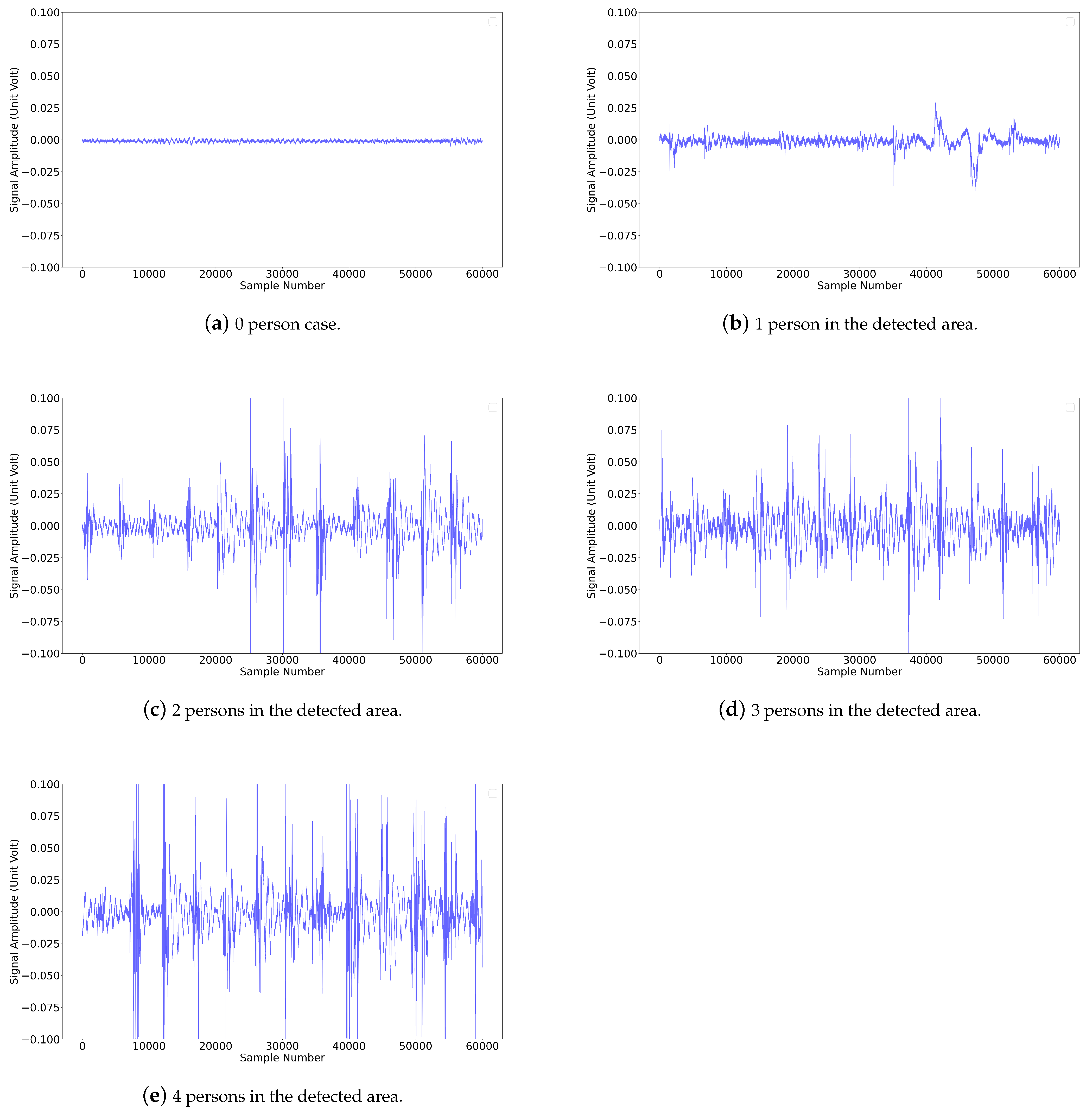



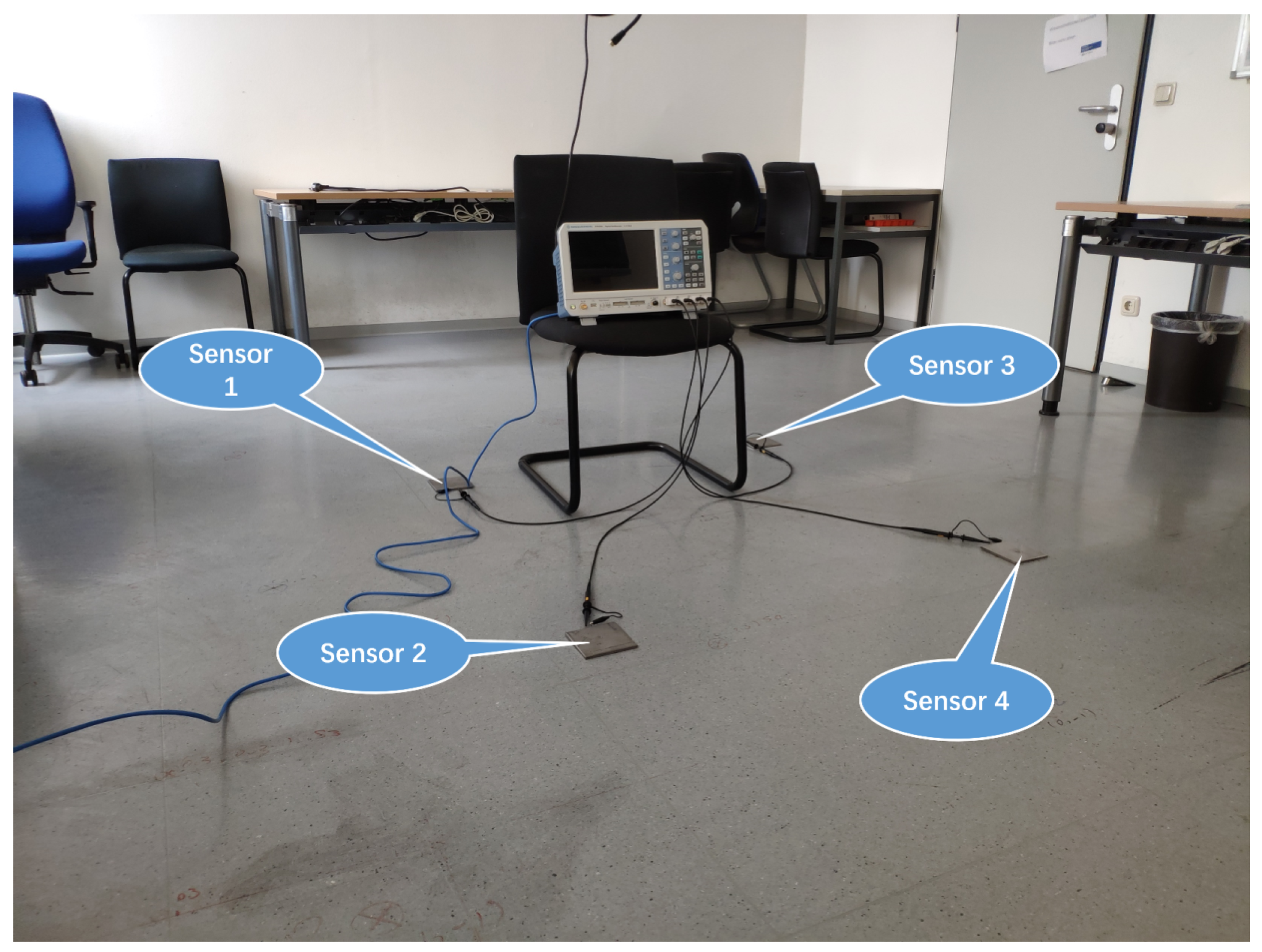
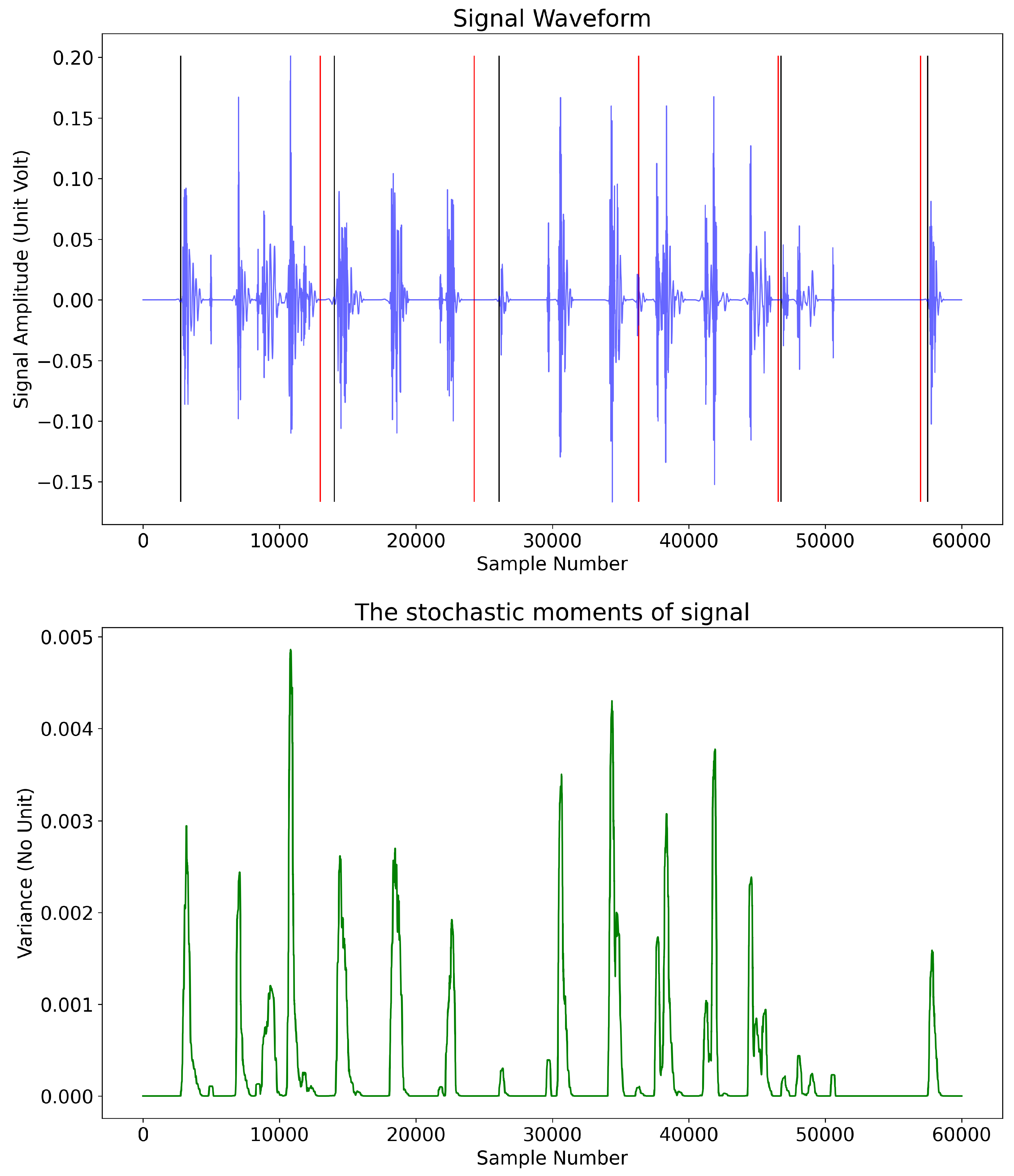

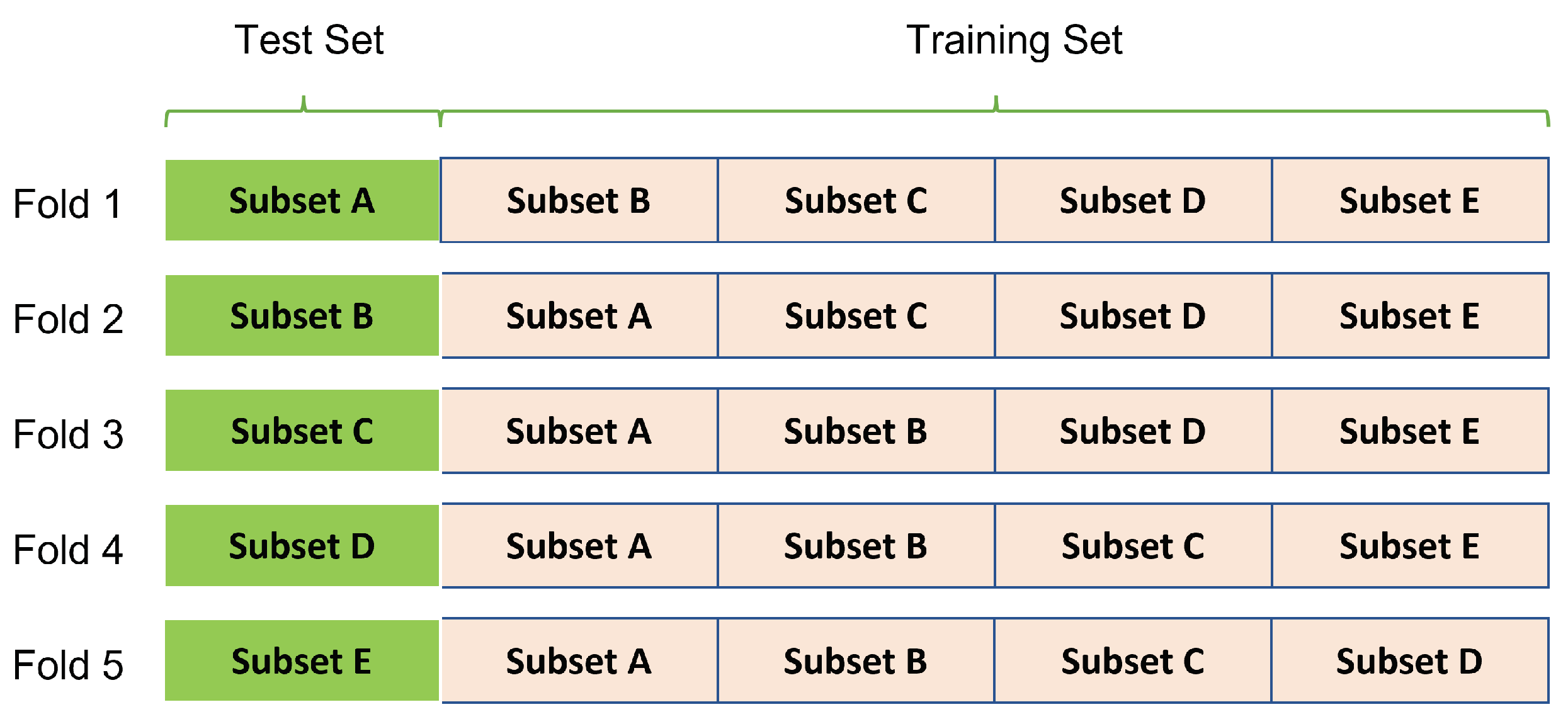
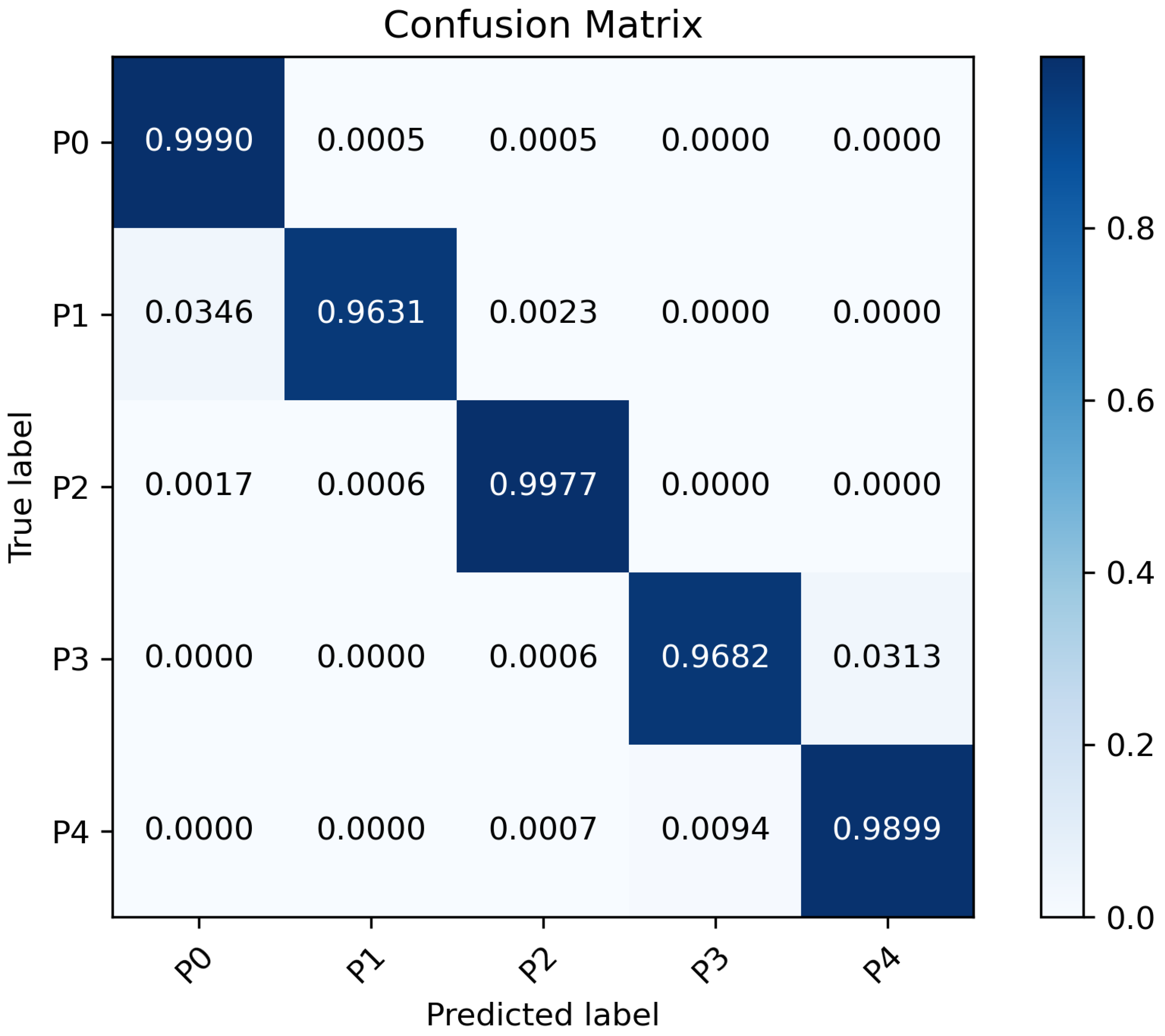
| Features for Pedestrian Counting | |
|---|---|
| (1) | Space-differential: Cross-correlation between SoIs from different sensors for the same footsteps. |
| (2) | Time-differential: Cross-correlation between SoIs for consecutive footsteps from the same sensor. |
| (3) | SoI duration. |
| (4) | Energy-specific: SoI signal entropy. |
| Approaches | Support Extreme Environment | Support More than One Person in the Detected Area | Support More than One Group of People | Device-Free | Privacy Protection | Resilient to Destruction |
|---|---|---|---|---|---|---|
| Camera-based [21,36] | - | ✓ | ✓ | ✓ | - | - |
| Device-based [2,3,4] | - | ✓ | ✓ | - | - | - |
| Li et al. [23] | ✓ | - | - | ✓ | ✓ | ✓ |
| Pan et al. [14,25,26] | ✓ | - | - | ✓ | ✓ | ✓ |
| Pan et al. [15,16] | ✓ | ✓ | - | ✓ | ✓ | ✓ |
| Our approach | ✓ | ✓ | ✓ | ✓ | ✓ | ✓ |
| P0 | P1 | P2 | P3 | P4 | |
|---|---|---|---|---|---|
| #Samples | 1954 | 3440 | 4752 | 5181 | 5628 |
| Precision | Recall | F1-Score | |
|---|---|---|---|
| 0 Person | |||
| 1 Person | |||
| 2 Persons | |||
| 3 Persons | |||
| 4 Persons | |||
| Accuracy | |||
| Micro Average | |||
| Macro Average |
Publisher’s Note: MDPI stays neutral with regard to jurisdictional claims in published maps and institutional affiliations. |
© 2022 by the authors. Licensee MDPI, Basel, Switzerland. This article is an open access article distributed under the terms and conditions of the Creative Commons Attribution (CC BY) license (https://creativecommons.org/licenses/by/4.0/).
Share and Cite
Yu, Y.; Qin, X.; Hussain, S.; Hou, W.; Weis, T. Pedestrian Counting Based on Piezoelectric Vibration Sensor. Appl. Sci. 2022, 12, 1920. https://doi.org/10.3390/app12041920
Yu Y, Qin X, Hussain S, Hou W, Weis T. Pedestrian Counting Based on Piezoelectric Vibration Sensor. Applied Sciences. 2022; 12(4):1920. https://doi.org/10.3390/app12041920
Chicago/Turabian StyleYu, Yang, Xiangju Qin, Shabir Hussain, Weiyan Hou, and Torben Weis. 2022. "Pedestrian Counting Based on Piezoelectric Vibration Sensor" Applied Sciences 12, no. 4: 1920. https://doi.org/10.3390/app12041920
APA StyleYu, Y., Qin, X., Hussain, S., Hou, W., & Weis, T. (2022). Pedestrian Counting Based on Piezoelectric Vibration Sensor. Applied Sciences, 12(4), 1920. https://doi.org/10.3390/app12041920









